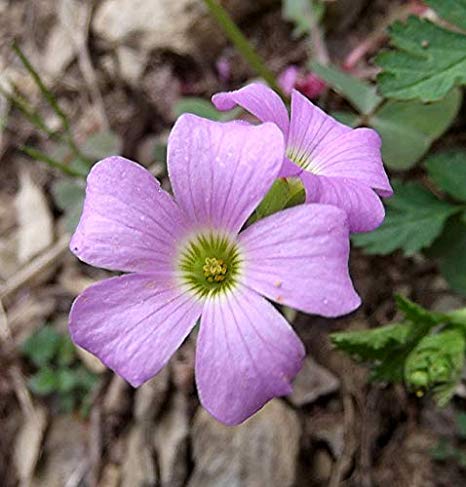Violet Wood Sorrel
Violet wood sorrel along with its close kin, the yellow wood sorrel and the creeping wood sorrel are all edible plants that add a lemony tang to your salads and can make a dandy form of lemonade.

I discovered wood sorrel, although I didn't know its name, when I was in preschool.
A classmate pointed it out to me. "Try these. They taste like lemons," she said. And so they did.
I'd pinch off a few of the tangy leaves and chew on them, swallowing the lemony liquid. Looking back, I'm glad I didn't make a steady diet out of them, and neither should you. Eating too much violet wood sorrel or any other sorrel can cause a problem with kidney stones, gout or rheumatism.
That's because wood sorrel is loaded with oxalic acid (hence its genus name Oxalis).
Too much oxalic acid in your diet inhibits the absorption of calcium, so you definitely don't want to eat it on a daily basis.
But this little plant is fine as long as you have it in moderation along with plenty of other good foods.
This lovely, delicate flower grows in the wild through a large portion of the United States and is considered an Old World plant coming from Europe.
Spotting Wood Sorrel
So how can you recognize it? This is a tiny plant with dark green or purplish, heart-shaped leaves that grow in groups of three, and the leaves will fold up either at night or in bad weather.
Sorrel will produce flowers in the spring that are either lavender, pink, yellow or white. The plant looks like clover, and the two are often confused, but both sorrel and clover are edible. The color of the plant will depend on the amount of exposure it gets to sunlight.
Where to Find Violet Wood Sorrel
It's called wood sorrel for a reason: You typically find it in wooded areas.
It's more prevalent in the eastern half of the United States, but I found it in Oklahoma, and it has also been found in Kansas and Nebraska.
It doesn't like competition, so it will more likely grow on bare ground.
Wood Sorrel Recipes
Wood sorrel added to any dish gives it a lemony flavor.
Add it to quiche, scrambled eggs and casserole dishes.
Because of its lemony taste, you can use it as a substitute for vinegar in salads.
Steep it in hot water for ten minutes and add honey or stevia for a lemony drink.
Sorrel also makes a tangy pesto by placing it in a food processor along with a tablespoon of olive oil, salt and garlic to taste. Blend until smooth.
By using a good guide like this one, you will be able to recognize not only sorrel but other edible plants that grow in the wild.
Medicinal Uses of Wood Sorrel
Violet wood sorrel and all other types of wood sorrel are rich in Vitamin C. Historically, this plant was used to treat fevers, urinary tract infections, colds and sore throats. It was also used in the past to treat scurvy and as a blood cleanser.
Wood sorrel can also ease nausea and increase the appetite.









New! Comments
Have your say about what you just read! Leave me a comment in the box below.